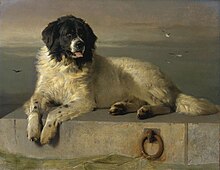Landseer dog
This article needs additional citations for verification. (October 2012) |
| Landseer | |||||||||||||||||||||
|---|---|---|---|---|---|---|---|---|---|---|---|---|---|---|---|---|---|---|---|---|---|
 Landseer | |||||||||||||||||||||
| Origin | Newfoundland (now part of Canada) | ||||||||||||||||||||
| |||||||||||||||||||||
| |||||||||||||||||||||
| Dog (domestic dog) | |||||||||||||||||||||
The Landseer is a dog breed. The breed is not recognized by all kennel clubs [citation needed]. It is not to be confused with a white and black Newfoundland, which is also often called a "landseer".
The breed was named after the British painter Sir Edwin Henry Landseer,[1] because in 1838 he created the painting A Distinguished Member of the Humane Society, which shows a dog of this breed.
Temperament
The Landseer Newfoundland dog is known for its sweet disposition, gentleness, and serenity. They enjoy swimming and tend to drool, though not as much as some other giant breeds.
History



During colonial times, large white and black "Newfoundland dogs" were brought to England. Because of their good swimming skills, these dogs were utilized by fishermen to tow nets to the shore. They were also noted for their ability to help drowning people; therefore, these dogs were bought and sold mainly by European fishermen. It is believed that, by and large, the exportation of these dogs occurred during the late 18th century. However, paintings show us that these dogs must have already existed in England in the early 18th century.
Because of their impressive appearance, they were the subject of numerous books and paintings.
The most famous painting of a large white and black dog of this type is a portrait called "A Distinguished Member of Humane Society" done by the renowned English animal painter Sir Edwin Landseer in 1838. In fact, the subject matter of many of Sir Edwin's paintings focused on these dogs. The dog portrayed in one of the most famous paintings is believed to have saved more than 20 people from drowning. It, therefore, was adopted as a member of the humane society.
Body
Males normally weigh 65–80 kg (143–176 lb), and females 55–65 kg (121–143 lb), placing them in the "Giant" weight range; but some Newfoundland dogs have been known to weigh over 90 kg (200 lb) – and the largest on record weighed 120 kg (260 lb) and measured over 1.8 m (6 ft) from nose to tail, ranking it among the biggest Molossers. They may grow up to 56–76 cm (22–30 in) tall at the shoulder.
In popular culture
Mr. Rochester's dog in Charlotte Brontë's novel Jane Eyre is incorrectly called a Newfoundland, but is, in fact, a Landseer.
The dog Nana in Peter Pan, although often portrayed as a St. Bernard, was intended to be a Landseer.
The 2004 movie Finding Neverland featured a Great Pyrenees as J. M. Barrie's pet, on whom Nana was based.
J. M. Barrie owned a Landseer Newfoundland called Luath.
Roxie from the movie A Dog's Purpose (film) is a black and white Landseer.
References
- ^ Kosloff, Joanna; Tana Hakanson (1996). Newfoundlands: Everything about Purchase, Care, Nutrition, Breeding, Behavior, and Training. Barron's Educational Series. p. 11. ISBN 978-0-8120-9489-3. Retrieved 2009-01-07.
- Knott, Thomas-Christian(Pacific Coast Landseers), based on Landseer Breed books 1-4 by the German Landseer Club (Deutscher Landseer Club)
